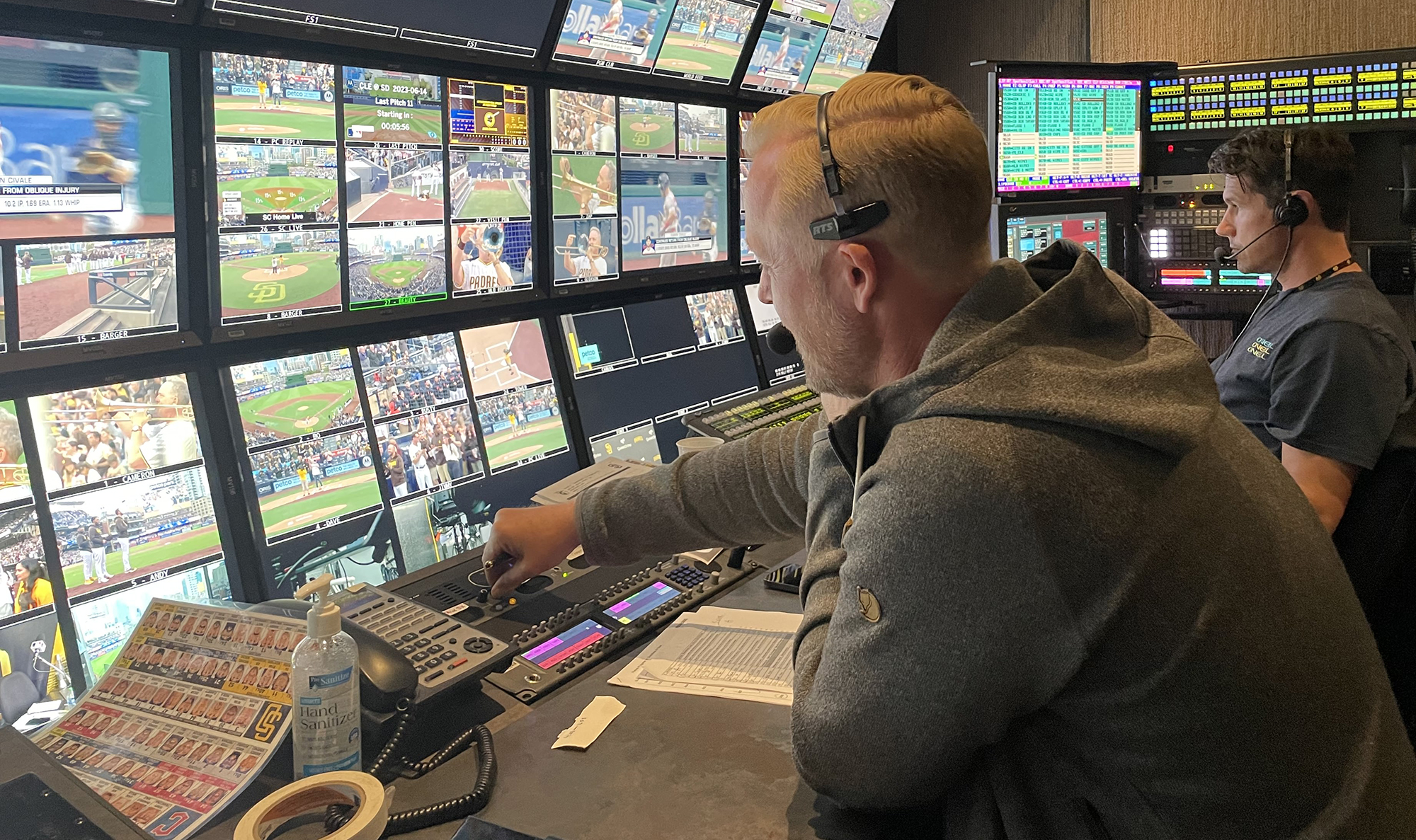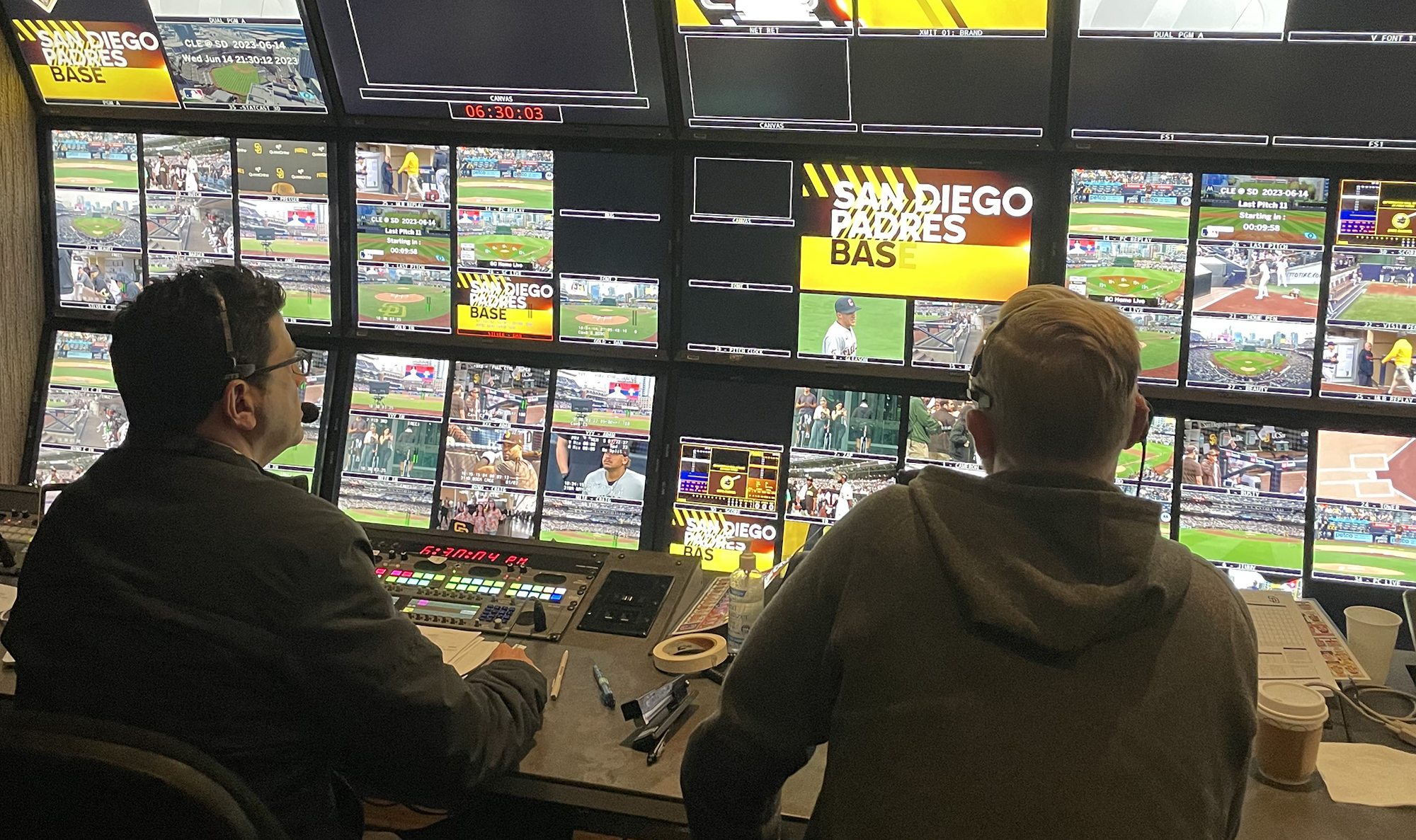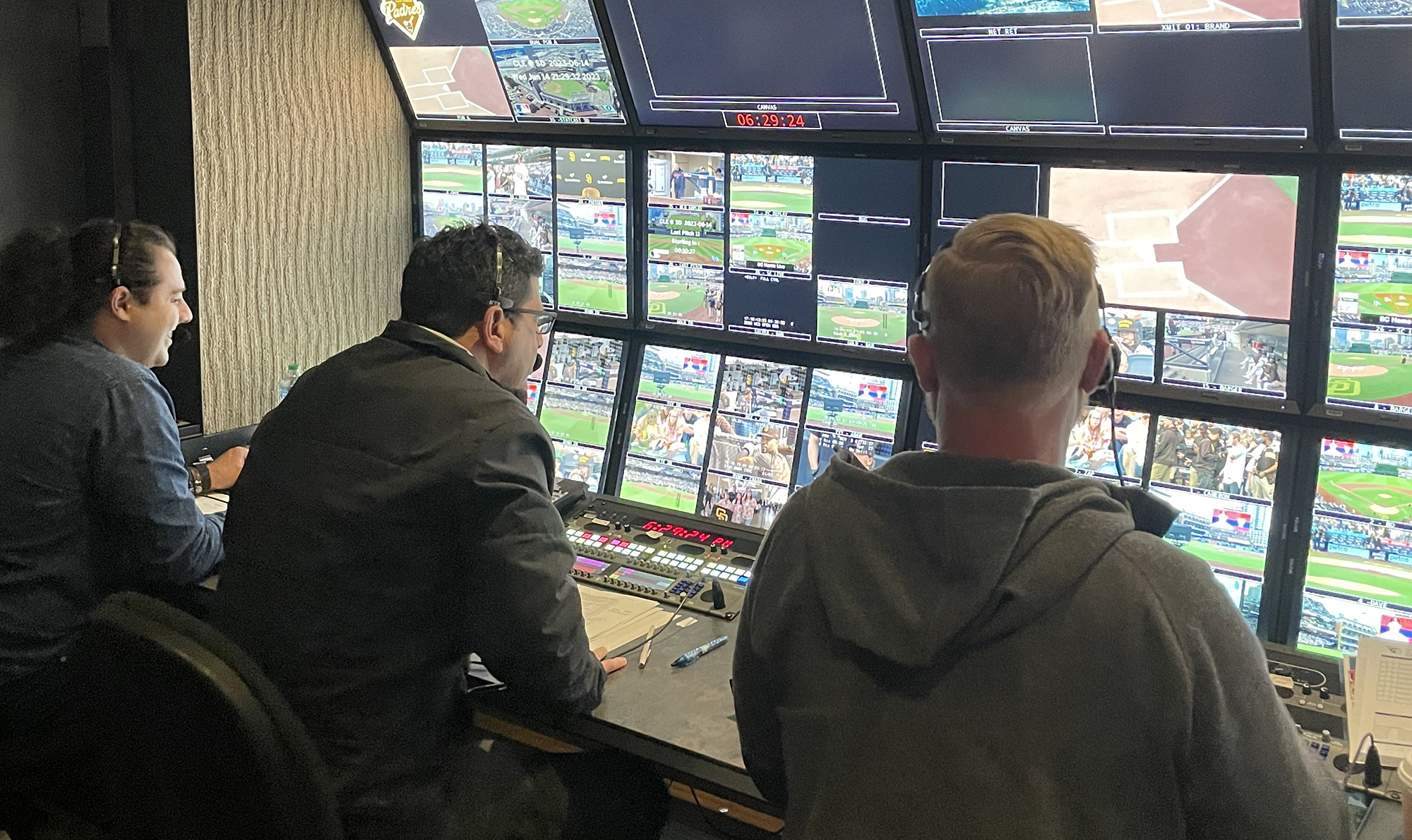Inside MLB Local Media’s Launch of San Diego Padres Productions and What It Means for the Future
New department is prepared for quick turnaround for other teams
Story Highlights
Largely lost in all the media chatter surrounding the San Diego Padres’ departure from Bally Sports two weeks ago was perhaps the most important factor: Padres fans didn’t miss a single pitch. That’s thanks to the seamless transition of broadcast operations from Bally Sports to Major League Baseball’s new Local Media department despite an ultra-accelerated timeline.
“In the Local Media Department,” says Doug Johnson, SVP/executive producer, Local Media, MLB, “we are excited we were able to deliver for our partner in the Padres. Our goal has always been to make sure the games are delivered each and every night to the fans, and we were able to do that under constant changing and crazy circumstances.”
Although the league had been preparing for a situation like this even before Bally Sports parent Diamond Sports Group filed for Chapter 11 bankruptcy protection in March, the transition of Padres broadcasts was abrupt nonetheless. Just 24 hours after DSG officially missed its rights-fee payment to the Padres (negating the Bally Sports rights deal), MLB Local Media had taken over production of all the team’s locally distributed games and was distributing them to multiple MVPDs and a new DTC service hosted by MLB.TV.
New Era for MLB Broadcasting: Building a Department From Scratch
MLB’s Local Media department officially started when the league hired Billy Chambers, previously CFO and COO of Sinclair Broadcast Group’s RSNs, to run the operation in January and, in March, he brought in Johnson, Local Media SVP Greg Pennell, and VP, Local Media Technical Operations, Kendall Burgess.

Inside MTVG’s 44FLEX mobile unit in San Diego during the first Padres game produced under MLB Local Media on May 31
Johnson and company knew that the turnaround would be quick if and when they had to take over broadcasts for an MLB team. So one of the first things they did was connect with the MLB Network team led by SVP, Production, Marc Caiafa; SVP, Creative Services, Chris Mallory; and SVP, Operations, Susan Stone.
“It was an all-hands-on-deck situation,” say Johnson. “Chris and his creative team quickly built an entire look for us to use. They had to tailor the look to each individual team’s color schemes. which took countless hours. Within two weeks, we had our first team package built and ready to get us on the air. It was amazing to be a part of such a [high-speed] turnaround like this.”
As each week passed, the Local Media team continued to add more elements so by the time it took over the Padres broadcasts on May 31, it had a full arsenal of on-air elements ready to go live on a moment’s notice.
“It gave us time to add such things as the Bob Costas tease that we used to announce the beginning of this new era of Padres coverage,” says Johnson. “It was great to be in a position where we could start adding the cool elements that were built by [Director, Production,] Matt Ciancimino and his team at MLB Network. The line in the Costas tease about being backed by the power of Major League Baseball was not just a line. It was a reality we witnessed each day as we got up to 100% speed.”
Part of the plan was to identify a master-control facility and distribution vendor. With guidance from Stone and her team and VP, Programming and operations, Eric Eisenberg, MLB Local Media selected Comcast Technology Solutions (CTS). In a short time, CTS was able to implement MLB’s first local channel for the Padres with plans to add more as the need arises.
Lightning-Fast Turnaround: Ramping Up Productions in Miami, San Diego
When Johnson and his team knew that the Padres situation was changing, they quickly formulated a plan to be in Miami for the Padres’ three-game series with the Marlins just in case they needed to take over. Making matters even tougher was the fact that MLB and the Padres could potentially take over in the middle game of a three-game series on the road.

Because the entire Padres production team was in San Diego doing cloud-based shows, MLB Local Media brought in its own team to prepare to cover the two games. Johnson says MLB Network Senior Segment Producer Tim Fryer, who ended up producing the two games in Miami, and Senior Graphics Operator Tim Bausch were instrumental in the successful launch.
“By the time we found out, late on Tuesday the 30th, that we were going to have the last two games, we were fully ready,” says Johnson. “Starting on the 30th, it was a whirlwind of meeting talent and finalizing our production plans. [Padres announcers] Don Orsillo, Mark Grant, and Bob Scanlan were incredible working with a new production team, and it led to a highly successful launch the night of the 31st.”
After producing the first two games in Miami, the entire MLB Local Media group boarded a plane Thursday night and flew to San Diego. They launched home-game productions on Friday with the existing freelance crew that had served Bally Sports San Diego.
“Producers Jason Lewis and Steve Rose and directors Zack Jensen and Tom Connole were 100% on board,” says Johnson. “I was amazed at how seamless it was on the first game and the entire first weekend. You could see the broadcasts grow as they got used to the elements.”
After gaining back the Padres rights, MLB Local Media was able to secure, through a partnership with Program Productions Inc. (PPI), San Diego-based technicians, including the producers and directors at the front bench and the entire local technical crew. In addition, it tapped Mobile TV Group to provide live-production services, including the mobile unit — 44FLEX and 44VMU — and MTVG’s veteran engineers previously assigned to Bally Sports San Diego.
“We wanted to retain as many of the talented folks who were working on these shows as possible,” says Johnson. “There are so many amazing people working on these local broadcasts that it only made sense to bring them over if we could. They know the teams and the city and have a great relationship with the team already established.”
New On-Air Identity: Inside Construction of the Graphics Package
The graphics package for Padres game broadcasts was assembled by Mallory and his creative-services team at MLB Network. It was a look that MLB Network had used previously but was tailored to the specific team. Instead of building a single graphics package for national games with one color scheme, MLB Network’s creative team had to customize the package for each team. That required specific color schemes and replay moves for each team.

“A process that you normally start six to nine months before a season starts was turned around in two weeks,” says Johnson. “An amazing feat by Chris and the incredible folks in his department.”
As MLB Local Media and the production team get more reps, they are gradually adding new elements to the shows, including specialty teases and player tease videos.
“We want these shows to be at a high level each night and to evoke an emotional response from fans,” says Johnson. “We want these shows to feel special and created [specifically] for each set of fans.”
Boosting the Tech: Shallow–Depth-of-Field RF Cam, J2K Transmission
From day one, Burgess’s goal was to replicate the existing equipment levels and technical specs on Padres game broadcasts. The challenge she faced, though, was that existing RSNs acquire equipment through capital purchases over several years, whereas MLB Local Media was expected to replicate that immediately.

Through a partnership with MTVG, led by President Philip Garvin and COO/Managing Partner Nick Garvin, she not only was able to secure the gear that the Padres crew was accustomed to but even added new technology to enhance the broadcasts, including a shallow–depth-of-field RF camera on the field.
The RF camera features a full-format imager, providing shallow depth of field in 1080p or better resolution. It “floats” on a Steadicam-like gimbal, allowing smooth motion even when the operator is moving. For the wireless transmission, Johnson says, the system uses the latest drone technology, which achieves high-quality images over a thousand feet away.
“In a short time frame,” he notes, “we were able not only to replace gear accumulated over years but also to add items that increased the overall production value of the broadcasts. Our goal has always been to start day one right where these shows left off and then build from there. The key is to get your feet under you and get the crews comfortable with the new look.”
As transmission vendor, MLB Local Media selected The Switch based on its availability at all MLB parks and its existing relationship with MLB Network. According to Johnson, the J2K feed for Padres telecasts has a higher bandwidth and lower latency, providing superior signal quality to the viewer at home.
Boosting the Talk: A Studio Show on the Field
One of the biggest changes MLB Local Media made was the location of the pre/postgame show. Instead of rolling out a physical set at Petco Park, MLB Local Media opted to put its on-air talent on the warning track outside the dugout and have them always standing to create a more fluid and authentic feel. The new location also allows the talent to have access to live side-by-side player interviews in the pre/postgame show that weren’t possible before.

“Thirty years ago,” Johnson says, “the pregame and postgame were done from a folding chair on the field at one of the low positions, which was not a very aesthetically pleasing shot. Over the years, pre/postgames moved to locations throughout the stadium with rigid sets and desks that looked nice but limited the movement of the talent and overall feel of the shows. We decided to return the shows to the field of play and to give them a different, more fluid feel. As the rightsholder, you want the shows to feel special, and nothing is more sacred than the field of play.”
Johnson’s eventual goal is to shoot these pre/post shows with the new shallow–depth-of-field RF camera with constant movement as the talent moves with the flow of the camera.
“I have told all our staff and crew that the first game was about getting comfortable and then we look to improve and add to each game after that,” says Johnson. “You have to build each broadcast like a house: you start with a solid base, which is your core crew and facilities, and, as everyone gets comfortable, you start adding bricks to that house; before you know it, you have a beautiful mansion. That’s our goal.
“I look forward to working with the Padres on increasing access to players,{ he continues. “As these broadcasts evolve over time, fans are craving access even more than new technology.”
Looking Ahead: More MLB Teams on the Horizon?
With two weeks of Padres broadcasts under its belt, the MLB Local Media team is off and running. And, with a Thursday deadline for DSG to either pay the Texas Rangers for 2023 local-TV rights or terminate its Bally Sports contract (and payments to three other MLB teams are due on July 1), Johnson and company are ready for whatever comes at them.
“The main takeaway from the launch of the Padres broadcasts was the final confirmation that we are ready to go,” he says. “With such a quick turnaround, it was incredible to see it all come together. I have been absolutely thrilled at how the broadcasts have gone so far. Our amazing crew on the ground in San Diego embraced the change and, I feel, were happy to just be doing games again. There has been a lot of uncertainty in our industry, and it was nice to see all the talented folks in San Diego focus on what they love, and that is doing the games.”
